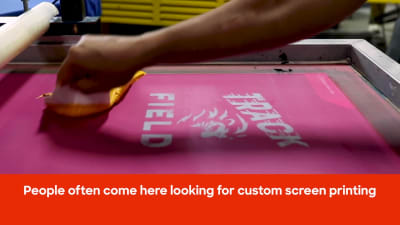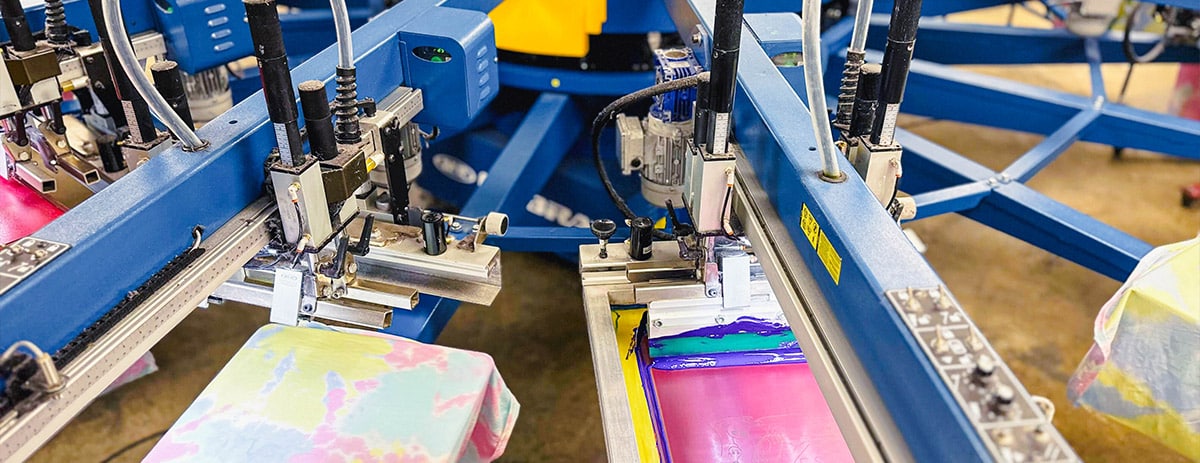High-Volume T-Shirt Printing for Schools and Organizations
High-Volume T-Shirt Printing for Schools and Organizations
Blog Article
Display Printing Uncovered: Every Little Thing You Need to Know Regarding Tee Shirt and Garment Printing Techniques
If you've ever before asked yourself just how those vibrant designs wind up on your preferred tees, you remain in the best location. Screen printing is a fascinating technique that integrates art with technique, using unlimited possibilities for imagination. Comprehending the fundamentals, from tools to ink choices, can considerably affect your results. Ready to discover the important components that make screen publishing an art kind? Let's discover the information that can raise your jobs.
The Fundamentals of Screen Printing: Just How It Works
When you plunge into screen printing, you'll discover it's both a science and an art. At its core, screen printing includes creating a stencil, or screen, that enables ink to pass through just in particular areas.
Setting the display over the textile, after that utilize a squeegee to press ink via the screen onto the garment. Each step is necessary, and understanding them will elevate your display printing skills, changing straightforward garments right into one-of-a-kind, meaningful pieces.
Types of Screen Printing Strategies
Once you understand the basics of screen printing, it's time to explore the different methods that can elevate your designs. One prominent approach is typical display printing, where ink is pressed via a stenciled screen.
One more alternative is plastisol printing, known for its resilience and brilliant shades, making it a favored for numerous brand names. Experiment with halftone printing to develop slope effects and detailed designs.
Necessary Devices for Display Printing
To attain sensational results in display printing, having the right tools is fundamental. You'll require a tough screen printing frame, which holds the mesh that moves your design onto the garment. Next off, spend in premium squeegees; these are important for applying ink evenly throughout the screen.
Selecting the Right Inks and Products
When picking inks and materials for display printing, you need to consider the kind of ink that works best for your task. Believe regarding fabric compatibility to guarantee your designs look last and fantastic lengthy. Also, explore environment-friendly ink options to make your printing procedure extra sustainable.
Kinds Of Display Inks
Picking the ideal display ink is essential for attaining lively, long lasting prints that meet your task's needs. There are numerous sorts of screen inks to take a look at. Plastisol ink is prominent for its adaptability and ease of use, supplying outstanding color opacity on dark textiles. Water-based ink, on the other hand, offers a softer feeling and is eco-friendly, making it excellent for those looking to minimize their environmental impact. Release inks get rid of color from the material, causing a soft, vintage look however call for particular handling. Lastly, specialty inks, such as metal or glow-in-the-dark, can add one-of-a-kind results to your designs. Review your job requirements and choose the ink that straightens ideal with your preferred result.

Fabric Compatibility Considerations
Understanding fabric compatibility is crucial for achieving top notch screen prints, especially considering that various products react distinctively to numerous inks. When choosing inks, take into consideration the fabric kind-- cotton, polyester, or blends. For cotton, water-based inks function well, offering soft qualities and breathability. Polyester, on the various other hand, frequently needs plastisol inks for much better adhesion and vibrant shades. If you're publishing on blends, you could need to use a combination of both types. Constantly evaluate your inks on example textile to ensure they stick appropriately and maintain color stability. In addition, bear in mind that material weight and texture can influence the last result, so selecting the right ink and material combo is important for your task's success.
Eco-Friendly Ink Options
Environmentally friendly inks are becoming a prominent selection for screen printers who want to reduce their environmental effect while keeping high quality. When selecting inks, consider water-based inks, which are much less harmful and less complicated to tidy up compared to typical solvents. These inks bond well with fabrics, providing vivid results without poisonous chemicals. You could additionally discover eco-solvent inks that utilize less volatile organic substances (VOCs), making them a safer alternative for both your health and the planet.
Furthermore, try to find inks made from renewable energies, such as soy or vegetable-based choices. By selecting the best inks and products, you'll not just produce sensational designs but likewise add to an extra lasting printing process. Make the button, and your prints will certainly show your dedication to the environment!
Preparing Your Layout for Screen Printing

Submit Format Needs
To assure your style looks sharp and vivid on fabric, you'll need to pay close interest to file format needs for display printing. Make certain your layout has a clear background to prevent unwanted white edges on your prints. Maintain shade modes in mind; CMYK is conventional for screen printing, so convert your RGB develops appropriately.
Shade Separation Methods
Shade splitting up is an essential action in preparing your layout for display printing, and grasping it can greatly enhance your print quality. You'll need to break your layout right into specific shades, as each color requires a different display throughout printing. Beginning by identifying all the shades in your layout and develop layers each. You can utilize software application like Adobe Photoshop or Illustrator to isolate and separate shades effectively. Be certain to conserve each layer as a different documents, normally in a style like TIFF or PSD. This precision not just assures exact shade representation but additionally simplifies the printing procedure. By paying focus to color splitting up, you'll accomplish expert and vibrant lead to your screen-printed garments.
Resolution and Size
Attaining the ideal outcomes in display printing starts with ensuring your design has the appropriate resolution and size. Ideally, your artwork should go to the very least 300 the original source DPI (dots per inch) for sharp, clear prints. If you make use of reduced resolution, your end product may look pixelated and unprofessional.
When it comes to size, consider the dimensions of your print area. Design your art work to match the last print size, ideally producing it in the actual measurements you'll be publishing. By doing this, you'll stay clear of any unexpected scaling issues.
Always inspect your layout in both vector and raster layouts. Vector graphics can be scaled without shedding top quality, making them ideal for screen printing. Preparing appropriately will guarantee your design looks amazing on every garment!
Step-by-Step Screen Printing Refine
Display printing is a vibrant process that enables you to create dynamic styles on different surface areas. To get started, you'll require a screen, emulsion, and your selected ink.
Put ink onto the display and utilize a squeegee to press the ink through the stencil onto the textile. Raise the display thoroughly and allow the print completely dry. You've successfully screen published your style.
Tips for Successful Screen Printing Projects
While you're diving right into your display printing tasks, bear in mind that prep work is essential to success. Start by collecting all your products-- inks, squeegees, garments, and displays. A clean work space helps protect against unwanted mistakes, so clean up before you start.
Following, validate your art work is high-resolution and appropriately sized for your garment. Test your display for proper exposure and clean it extensively to prevent spots. When blending your inks, comply with the manufacturer's guidelines to achieve the ideal uniformity.
Throughout printing, use even stress with your squeegee for regular outcomes. Don't hurry; take your time to confirm each print meets your criteria. After printing, let your garments completely dry entirely prior to dealing with or packaging them.
Last but not least, always keep an example of your help future referral. In this manner, you can assess your development and boost your strategies with time. Delighted printing!

Regularly Asked Inquiries
The length of time Does It Require To Establish a Screen Printing Task?
Establishing a display printing work generally takes around 30 mins to an hour. You'll prepare the displays, mix inks, and readjust the press. The time differs based upon complexity and experience, so stay arranged!
Can I Publish on Various Textile Types Utilizing the Same Technique?
Yes, you can publish on various material types using the same method, but you'll require to change your settings and inks. Some materials soak up ink in different ways, so trying out assurances the most effective outcomes for each and every product.
What Are Typical Errors to Avoid in Screen Printing?
When display printing, prevent usual errors like utilizing the wrong ink, overlooking correct direct exposure times, or skipping pre-press checks. Constantly check your configuration and keep tidy displays to assure top quality results each time.
How Can I Appropriately Clean and Keep My Screen Printing Devices?
To appropriately tidy and keep your display printing equipment, you ought to regularly clean screens with appropriate solvents, inspect squeegees for wear, and guarantee all devices are saved completely dry and dust-free. Consistency avoids pricey fixings and improves performance.
Is Screen Printing Ecologically Pleasant Compared to Various Other Techniques?
Display printing can be much more eco-friendly than various other techniques, particularly if you utilize eco-conscious products and water-based inks. By selecting sustainable supplies and techniques, you lower waste and lessen your influence on the earth.
Display Printing Uncovered: Everything You Required to Know Concerning Tee and Garment Printing Methods
At its core, screen printing includes developing a stencil, or screen, that allows ink to pass with only in specific areas. Placement the screen over the material, then use a squeegee to push ink via the Continued display onto the garment. One preferred technique is standard display printing, where ink is pressed with a stenciled screen.When picking inks and products for display printing, you need to take right into account the type of ink that works best for your project.
Report this page